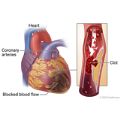Condition Basics
What is coronary artery disease?
Coronary artery disease, or heart disease, is a heart problem that happens when fatty deposits called plaque (say "plak") build up inside coronary arteries of your heart. Those are the blood vessels that supply blood and oxygen to your heart muscle. This process of plaque buildup is called hardening of the arteries, or atherosclerosis.
Plaque buildup may reduce blood flow to the heart muscle. Like any muscle, the heart needs blood to work well. Poor blood flow can cause angina symptoms, such as chest pain or pressure. If the plaque breaks apart, it can cause a heart attack.
What causes it?
Coronary artery disease is caused by a process called hardening of the arteries, or atherosclerosis. Fatty deposits called plaque build up inside coronary arteries. These arteries supply blood to the heart muscle. Over time, the plaque buildup may narrow the arteries and reduce blood flow to the heart muscle.
What are the symptoms?
The symptoms of coronary artery disease are angina and shortness of breath. Angina can feel like chest pain or pressure. Some people feel pain, pressure, or a strange feeling in the back, neck, jaw, or upper belly, or in one or both shoulders or arms. Symptoms typically happen when the heart works hard.
How is it diagnosed?
Your doctor will ask about your medical history and do a physical exam. You may have tests to check how well your heart is working and to see if your arteries are narrowed. Examples of tests include an electrocardiogram, an echocardiogram, stress tests, and a CT angiogram.
How is coronary artery disease treated?
Coronary artery disease is treated with healthy lifestyle changes and medicine. Treatment focuses on lowering your risk for heart attack and stroke and managing your symptoms. Sometimes angioplasty or bypass surgery is done to improve blood flow to the heart.














